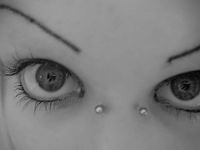Nose piercing: Difference between revisions
→Bridge piercing: A bridge piercing is not a surface piercing, in anyway. |
|||
| Line 17: | Line 17: | ||
A '''nasal septum piercing''' is less common than nostril piercings. The [[nasal septum]] is the cartilaginous dividing wall between the nostrils. Generally, the cartilage itself is not pierced, but rather the small gap between the cartilage and the bottom of the nose, typically at a gauge no smaller than 14ga (1.6mm). The nose has many nerves running through it and as a result, nose piercings can be painful, although it varies by individual. |
A '''nasal septum piercing''' is less common than nostril piercings. The [[nasal septum]] is the cartilaginous dividing wall between the nostrils. Generally, the cartilage itself is not pierced, but rather the small gap between the cartilage and the bottom of the nose, typically at a gauge no smaller than 14ga (1.6mm). The nose has many nerves running through it and as a result, nose piercings can be painful, although it varies by individual. |
||
There are |
There are many types of jewelry generally worn in a septum piercing. [[Captive bead|Captive bead rings]] (CBRs) are rings that close with a bead in the centre. Circular Barbells (as shown in the picture) have two beads which screw on. Additionally, one can wear a "tusk" which is a straight or shaped piece of material which is generally tapered on either end. Pinchers are another popular piece of jewelry worn in this piercing. |
||
Another option is a septum retainer, which is staple shaped. This type of nose piercing is particularly easy to hide when desired, for example to comply with a dress code. A septum retainer makes it possible to turn the jewelry up into the nose, thus concealing it. |
Another option is a septum retainer, which is staple shaped. This type of nose piercing is particularly easy to hide when desired, for example to comply with a dress code. A septum retainer makes it possible to turn the jewelry up into the nose, thus concealing it. |
||
Revision as of 08:01, 6 January 2007
Nose piercing is the piercing of the skin or cartilage which forms any part of the nose, normally for the purpose of wearing jewelry; among the different varieties of nose piercings, the nostril piercing is the most common. Nose piercing is one of the most common varieties of piercing after earlobe piercing.
Nostril piercing

Nostril piercing is a body piercing practice often associated with India. In India the outside of the left nostril is the preferred position of the piercing as this is supposed to make childbirth easier. This is because Ayurvedic medicine associates this location with the female reproductive organs [1].
Nostril piercing was first performed in the Middle East about 4,000 years ago [citation needed]. A nose ring was one of the gifts given to Rebekah, according to Genesis 24:47 [2]. From there the practice spread to India and parts of Asia. In India piercings were regarded as a mark of beauty and social standing in the 16th century.
Nose piercing is still popular in Pakistan, India and Bangladesh. It also remains popular in Middle Eastern and Arab countries.
Nostril piercing has in recent decades become popular amongst the industrialised nations, as have other forms of body piercing. Piercing was introduced by the hippie culture in the 1960s and '70s. Afterwards punks and subsequent youth cultures in the '80s and '90s adopted this sort of piercing. Celebrities such as Slash, Izzy Stradlin, Sinéad O'Connor, Madonna, Christina Aguilera, Nicole Richie, Del tha Funkee Homosapien, and Tupac Shakur have had their nostrils pierced.
Today, nostril piercing is popular in the U.S., UK, Canada, the Caribbean and Italy, with piercings being performed on either the left or right nostril. Both men and women have nostril piercings, although they are much more common among women. Some people have multiple nostril piercings, in either or both nostrils.
Nasal septum piercing

A nasal septum piercing is less common than nostril piercings. The nasal septum is the cartilaginous dividing wall between the nostrils. Generally, the cartilage itself is not pierced, but rather the small gap between the cartilage and the bottom of the nose, typically at a gauge no smaller than 14ga (1.6mm). The nose has many nerves running through it and as a result, nose piercings can be painful, although it varies by individual.
There are many types of jewelry generally worn in a septum piercing. Captive bead rings (CBRs) are rings that close with a bead in the centre. Circular Barbells (as shown in the picture) have two beads which screw on. Additionally, one can wear a "tusk" which is a straight or shaped piece of material which is generally tapered on either end. Pinchers are another popular piece of jewelry worn in this piercing.
Another option is a septum retainer, which is staple shaped. This type of nose piercing is particularly easy to hide when desired, for example to comply with a dress code. A septum retainer makes it possible to turn the jewelry up into the nose, thus concealing it.
Septum piercing was popular among certain Native American peoples in history; the Shawnee leaders Tecumseh and Tenskwatawa, for example, had such piercings.
Bridge piercing

Yet another nose piercing is the bridge piercing. This piercing is a piercing through the small flap of skin at the top of the nose, between the eyes. Barbell-style body jewellery is the most common jewellery worn in this piercing.
